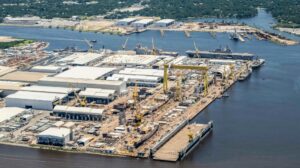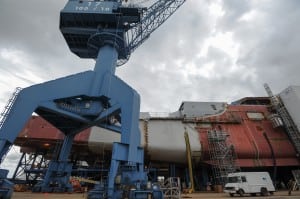The Navy shipbuilding industry needs to build new ships faster to prove it can utilize a record level of shipbuilding funds approved by Congress in the fiscal year 2023 budget, Chief of Naval Operations (CNO) Adm. Michael Gilday said this week.
While Congress has pushed the Navy’s shipbuilding account up to $31.5 billion, Gilday is not sure industry can keep up at the pace needed, he said at the annual Surface Navy Association symposium.

“I’ve said publicly that I didn’t think that you could put more than $27.5 billion, which was our [fiscal year 2023] proposal, into seven shipyards across the country, five of which build surface ships. I didn’t think we could put any more money against that problem set and Congress proved me wrong with a $31.5 billion shipbuilding account,” he said.
During his remarks, Gilday outlined the surface shipbuilders’ profiles: Fincantieri’s Marinette Marine is finishing the Freedom-variant Littoral Combat Ship program and will shift to focus on the new Constellation-class frigate, General Dynamics [GD] Bath Iron Works has completed its work on all three Zumwalt-class destroyers and is “laser-focused” on Flight III Arleigh Burke-class destroyers, HII’s Ingalls Shipbuilding [HII] has mature production lines also building the destroyers as well as America-class amphibious assault ships and San Antonio-class amphibious transport dock ships and GD NASSCO is building the new John Lewis-class replenishment oilers.
Between Congress appropriating a $31.5 billion shipbuilding budget and $19 billion Navy aircraft budget, the CNO said these are “phenomenal numbers, we’re incredibly fortunate and grateful for the support we’re getting.”
Congress also directed the Navy to increase the overall pace of procurement up from buying two Arleigh Burke-class destroyers per year to three per year.
However, Gilday said while the Navy has 80 ships on contract and 54 ships across seven shipyards currently under construction, “we’re not necessarily getting what we’re paying for” comparing annual procurement to what industry has been able to deliver so far.
The Navy and industry are starting to consider the design of the next-generation large combatant to succeed DDG-51, DDG(X), but he said he is focused on getting the latest version of the Arleigh Burke-class operating efficiently.

“My priority right now is making sure that we get the Flight III DDG lines humming. And so the latest signal from Congress has been three a year. What industry has to do is prove to us that they can produce three ships a year, get them out there at three a year. We’re not there yet,” the CNO said.
“My message to industry would be to pick up the pace. And I know it’s easy for me to say that, but we’re paying a lot of money…and we’re not necessarily getting what we’re paying for with respect to two to three ships per year. We’re just not at that production rate,” he continued.
Gilday said destroyers are not the only problem with production rate, noting Virginia-class attack submarine (SSN) shipbuilders are not building the two vessels per year rate the Navy needs over the next two decades. He said the current rate is only producing around 1.2 SSNs per year, which is “not good enough in this decade.”
He acknowledged constraints on the workforce and supply chain problems and the Navy is trying to help get to a better position on that, “but we just need to do better.”
When asked by reporters after his remarks what incentives the Navy can offer the shipyards for more stability to improve its production rate, Gilday said the FY ‘23 defense authorization and appropriations bills should be incentive enough now.
“As an example, Bath and HII are not producing a combined rate of three DDGs a year. The ‘23 budget gave them funding for three DDGs a year. So that’s a bellwether for them and a new target to aim for. And I’m really anxious for them to aim for it and go for it. So that’s why my comment – ‘prove it’.”

When asked if the shipbuilding base is at capacity, Gilday said only the shipbuilders can answer that.
“All I can tell you is right now, I see them a little bit behind on some of our production lines. And so they would tell you…that they can do more. And so my message to them is ‘prove it.’”
While Bath Iron Works has not been producing even one DDG-51 destroyer per year, Gilday said he is optimistic now that they have completed the Zumwalt-class and are “solely focused on DDGs.”
“ So to get that single line, which will, in the not too near-distant future, be just Flight III DDGs.”
He also noted HII and Bath Iron Works is concurrently helping the Navy with the DDG(X) design.
“So what we’ve learned from previous shipbuilding lines is that we’ve had our greatest success when Navy’s had the lead, informed by industry. So we’re working very closely with them right now. So we get that right. And that also means getting that transition plan in right from Flight IIIs to DDG(X).”